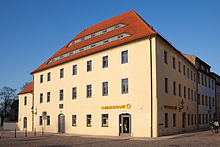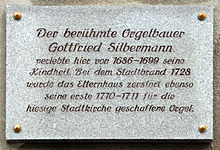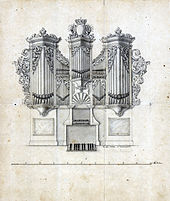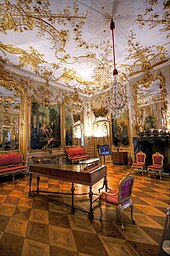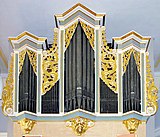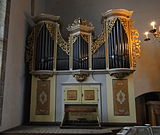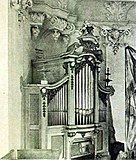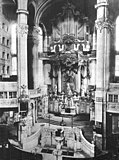Gottfried Silbermann

Gottfried Silbermann (born January 14, 1683 in Kleinbobritzsch , † August 4, 1753 in Dresden ) is considered to be the most important central German organ builder of the Baroque period . He incorporated Alsatian influences into Saxon organ building and created instruments that were famous even during his lifetime. Of a total of 50 new organs built by Silbermann, 31 have been preserved and have a lasting impact on the organ landscape in Saxony . The organs that he and his brother Andreas Silbermann and his son Johann Andreas Silbermann built are known all over the world as "Silbermann organs". Gottfried Silbermann also built stringed keyboard instruments, including harpsichords , clavichords and fortepiano , and pushed ahead with their further development.
Life
The Silbermann family can be traced back to Gottfried's great-grandfather Georg († before 1619). This can be traced back to 1595 as a trader in Kleinbobritzsch, where his son Veit (* between 1584 and 1591; † 1666) was a "manual worker" and owner of a half-hoofed estate . Gottfried's father, the farmer and later carpenter Michael Silbermann (* late August 1640; † 24 May 1713), married Christina Tröger on 9 July 1660 († 6 March 1676). The marriage had four children. On September 17, 1667 Michael married Anna Maria Preißler (* 1652; † May 20, 1724) from Großwaltersdorf . The two were born in 1678 the later organ builder Andreas, in 1683 Gottfried and in 1696 the early deceased Abraham († 1697).
At the turn of the year 1685/1686 the family moved to the neighboring town of Frauenstein . Little is known about Gottfried Silbermann's youth. Like his brother Andreas, he attended the city school in Frauenstein. The thesis that he successfully completed an apprenticeship as a bookbinder in Freiberg and was acquitted in 1697 does not match Silbermann's life data. On the other hand, Silbermann's statement in a letter dated June 9, 1733 indicates an early interest in organ building: "After I had a particular drive for organ building in my youth and learned it in Strasbourg ...".
Gottfried Silbermann went to Strasbourg in 1701 to learn the trade of organ building from his older brother Andreas, and on March 15, 1702, he became a citizen. There he built four organs together with Andreas and came into contact with the Alsatian organ culture. The first harpsichords were also made there. From 1704 to 1706, Gottfried was in charge of the workshop when Andreas was in Paris to study. Gottfried returned to Saxony as a master craftsman in 1710 , having promised his brother not to set up his own business in Alsace. On his trip he met the Thomaskantor Johann Kuhnau in Leipzig , who was enthusiastic about his theoretical knowledge and became an influential advocate of the young organ builder. After his application for a new organ in Leipzig's Paulinerkirche in 1710 was unsuccessful, he built his first organ in Germany for his hometown Frauenstein in 1711 and waived his wages, "because Frauenstein is my fatherland, to honor God and to love the church". In the same year Silbermann opened his organ building workshop in Freiberg , where the superintendent Christian Lehmann promoted and supported him. After almost four years of construction, he completed his second German project in 1714, the large organ in Freiberg Cathedral St. Marien. Silbermann remained single and lived in Freiberg until the end of his life. He created a total of five organs for this city, four of which have survived.
Silbermann's thought and action, which was oriented towards profitability, is remarkable , which enabled him to attain a level of prosperity that was unusual for an organ builder at the time. According to his nephew Johann Andreas Silbermann, some of the buildings were built much too cheaply. However, the income from piano building and his considerable private fortune allowed Silbermann to make generous calculations in organ building. His striving to get as many orders as possible can be seen:
“If I hadn't worked and only put my money, which I brought in Saxony, into Zinß, I would be richer than I am.” He added: “I just wanted to do everything, just me”. Because he recognized his affect aimed only at praise and fame. "
Silbermann knew how to expand and consolidate its position in the market almost to a monopoly position . In 1713 he took on Zacharias Hildebrandt as an apprentice, although he could not pay an apprenticeship fee. In return, Hildebrandt contractually undertook to work "in no way in Sachßen and Alsace in any way, to the detriment of him [= Silbermann] after completing his training". When Hildebrandt did not keep to the agreement, a long legal battle broke out between the competitors in the early 1720s. Elector Friedrich August I (August the Strong) decided in 1724 that Hildebrandt was only allowed to take on those orders that Silbermann had previously rejected. By 1746 at the latest there was a reconciliation between the two organ builders.
Not all of Silbermann's building principles were approved by contemporaries. The criticism by Johann Sebastian Bach is an example of this, who took different views on the question of the mood system . Bach criticized the stiff touch of Silbermann's first fortepiano and the insufficient sound strength in the upper tone range. The relationship between the two remained distant; evidently at Silbermann's instigation, Bach was not called in as a reviewer when his completed organs were checked. The only verifiable encounter came in 1746, when Bach and Silbermann were jointly required as organ experts for the acceptance of the newly built Hildebrandt organ in the Naumburg town church of St. Wenzel , examined the organ for four days and wrote a positive report together. However, this was remarkably tight and omitted all points that were controversial between the two.
Silbermann fell seriously ill with gout in 1749 . He therefore entrusted the new building in Frankenstein to his employees and the organ building of the Dresden Catholic Court Church to his former student Zacharias Hildebrandt, who played a major role in this work. Silbermann died as a result of the illness. He was buried on August 8, 1753 in the Johanniskirchhof in Dresden; his grave has not been preserved. In his will, Silbermann, who was never married and was childless, appointed his nephew Johann Daniel Silbermann (1717–1766) as a universal heir; he received his estate of 10,307 thalers. Clothes, beds and household appliances went to his colleague Johann Georg Schön. Presumably, Johann Daniel also left the tools for organ building and the wood and tin supplies to Schön. A portrait of Gottfried Silbermann has not survived.
plant
Organs
Silbermann's organs show a clear and consistently applied concept in their tonal, technical and architectural form. This applies to both the external and the musical form. Silbermann, who is said to have a conservative attitude, never deviated from this line throughout his life. The housings enclose a compact structure. Reverse positives were never carried out. The brochures can except Freiberger cathedral organ to work building not recognize. They are kept relatively flat, divided into round or pointed towers and flat fields, finished over the pipes by carved veils, rarely lambrequins . Silbermann took over the space-saving idea of a backwork from Hildebrandt for small two-manual organs. In contrast to the Silbermann workshop in Strasbourg, Gottfried Silbermann occasionally built pedal links to the main work; With small organs, the pedal is usually attached to the (main) manual. As was common in the 18th century, smaller organs only have a few 16- and 8-foot registers in the pedal. Silbermann did not use spring shops , multi-choir mixtures and transmissions or the Zimbelstern . The sound crowns are relatively low, repeat uniformly on c 0 , c 1 and c 2 and have few choirs. A widely standardized type of organ with standardized lengths and casings, simple mechanics and a more conventional disposition enabled high efficiency and fast delivery times. The manual range is usually 48 keys (CD – c 3 ), with six organs 50 keys (CD – d 3 ), the pedal range CD – c 1 . Silbermann limited himself to five types of organs, which can be clearly distinguished from one another:
- single manual positive and small organs without pedal with 5–8 manual registers (Opus 2, 7, 15, 19, 21, 35–37)
- single-manual organs based on the principle 8 ′ with 9–15 stops (opus 5, 8–10, 13, 17, 18, 23, 26, 27, 31, 47, 49)
- small two-manual organs without 16 ′ in the manual with 17–21 stops (opus 1, 3, 11, 22, 28, 29, 32–34, 41, 44–46, 48)
- large two-manual organs with 16 ′ in the manual with 22–32 stops (opus 12, 14, 16, 20, 24, 30, 38, 40, 42)
- three manual organs with 43–47 registers (opus 6, 39, 43, 50)
In addition, Silbermann had great organizational skills and an economical, manufactory-like division of labor in the workshop, in which around half a dozen employees were employed. The production of larger organ parts and the metal pipes usually took place on site. In some cases, there is evidence of cooperation with local suppliers and craftsmen. Carpenters on site created the oak casing according to precise specifications. A sculptor was usually contracted for the decoration in the prospectus . Silbermann strove for a regional monopoly position and had this secured through princely privileges. On June 30th, 1723 he received the privilege of the royal "Hof- und Land-Organ-Builder" from the Saxon Elector Friedrich August I, who was also the Polish King. He refused lucrative contracts abroad (Moscow, Petersburg, Copenhagen, Prague) on principle and concentrated on a field of activity within a radius of around 35 kilometers.
In research, the question of which organ temperature (s) Silbermann used is controversial . This is due to the fact that no statements by Silbermann about organ tempering have been handed down and almost all of the organs he has survived have been re-tempered over the course of time and have mostly been given an equal tuning . It is often believed that Bach demanded an expanded, more flexible tuning , while Silbermann insisted on the mean-tone tuning system. According to Herbert Kelletat , on the other hand, Bach agreed in principle to Silbermann's mean-tone tuning and never criticized it. According to Frank-Harald Greß , Silbermann represented a kind of medium-tone, later a well-tempered, mood until around 1716 . However, this is not identical to the so-called Silbermann-Sorge temperature . The Silbermann tuning was reconstructed by Wilhelm Dupont (1935), John Murray Barbour (1951), Werner Lottermoser (1965), Helmut KH Lange (1966/1968) and Bernhard Billeter (1979/1997).
According to tradition, Silbermann determined the acoustic situation of the church to be equipped with an organ by tapping the floor in the middle of the church with a brass-studded Spanish pipe , listening carefully to the reaction of the room, and thus determining the essential parameters of the future organ.
In terms of sound, Silbermann's early works were influenced by French classical music. In each work there is a strong colored cornet , either as a mixed register or in individually registerable rows. From 1720 Gottfried Silbermann broke with the French tradition and mainly built three-horn cornets from c 1 in the main factory . They were given a different location directly on the drawer near the prospectus and also required a different registration , since, according to Silbermann, they should be used together with an 8 'and a 4' for solo purposes. In small, single-manual organs, they are used for Grand Jeu registrations. Examples of German influences include gamba, quintadena and registers in a one-foot position. Unlike his brother Andreas, Gottfried built registers such as pointed flutes, Gemshorn and Viola di Gamba (a relatively wide pointed flute) in a conical design. For the open registers, including the quintadena , the Freiberg workshop used an alloy with a high proportion of tin, while only the pipe body of the Gedackten and reed flutes contained a lot of lead. Silbermann achieved a brilliant as well as powerful, solemn sound of the full organ (" plenum "), as it was necessary to accompany the congregation chant and for representative figural music (worship ensemble music ), through high wind pressure and a very wide labiation of the pipes.
Silbermann used the best materials, including high-percentage English pewter. The organ builder was certified by his contemporaries to have the highest level of craftsmanship and artistic skill. The master always reserved the intonation of the pipework himself. As far as is known, no defects in the instrument were found or improvements were requested during any organ acceptance. Some parishes even decided not to have their new organ checked because they obviously trusted Silbermann and in order to save the costs of external experts.
Problems with later restorations were caused by the small wall thicknesses of the metal pipes that Silbermann had chosen in his first organs (including the one in Pfaffroda), which had an unfavorable effect on the long-term stability of the pipes. Later he increased the material thickness a little, which made the pipes much more stable.
Gottfried Silbermann created around 50 organs in the course of his activity. 31 organs are still preserved in Saxony, including the famous instruments in Freiberg and in the Catholic Court Church in Dresden.
At times the Silbermann organ was thought to be the ideal Bach organ. Apart from the probable differences of opinion between Silbermann and Bach on questions of mood (see above), it is questionable whether Silbermann's dispositions met Bach's requirements in every detail. The Bach student Johann Friedrich Agricola criticized and praised the following aspects:
“In his organs, true organ connoisseurs [primarily meant Bach] find nothing more to criticize than: the all too monotonous disposition, which simply out of an exaggerated cautiousness to venture nothing of voices, of which he was not quite certain that he was nothing would fail in this, originated; also the all too insane temperature, and finally the all too weak mixtures and cymbals ... Three things, all of which he could have changed very easily. On the other hand, connoisseurs admire: the excellent cleanliness, quality and durability, of the materials as well as the work; the great simplicity of the inner structure, the extraordinarily splendid and full intonation; and the pianos, which are extremely easy and comfortable to play. "
Reed voices , whose “great friend” Bach was, according to Agricola's testimony, are sometimes used sparingly (on small two-manual Silbermann organs they are completely absent in the manuals). Silbermann's mostly mixer-free pedal hardly has any cantus firmus or overtone registers, as Bach's pedal part often requires, and in some compositions Bach exceeded the keyboard range chosen by Silbermann (CD – c 3 , pedal CD – c 1 ). The organ expert Klinda sums it up as follows:
"Silbermann's work was an essential contribution to the art of organ building, but his instruments do not correspond to Bach's organ ideal, although many of Bach's works can be interpreted artistically satisfactory on these organs."
With regard to its complaint about the "too weak concoctions" Agricola seems but obviously not to have been familiar with the registration instructions Silbermann, who to brighten the "plenum" always the overhead register Quinte 1 1 / 3 'and Sifflet 1' and a coupling of the manuals provided. Silbermann designed the mixtures higher in smaller organs, which Bach and Agricola had probably not known.
Stringed keyboard instruments
Gottfried Silbermann was not only famous as an organ builder, but also as a builder of harpsichords, clavichords and fortepianos. During his time in Strasbourg, he was already building stringed keyboard instruments as an apprentice and journeyman for his brother Andreas. The production of harpsichords and clavichords reached its first peak in the 1720s and led to a large number of exported “pianos” in the 1740s, including those for the Schwarzburg-Rudolstadt and Prussian courts.
Silbermann was involved in the further development of instrument making. Inspired by Regina Gertrud Schwarz (wife of Johann Ulrich von König ), he had an essay printed with a copper engraving about the "Clavessin d'amour" or "Cimbal d'amour", a large clavichord, which he invented around 1720. Friedrich August I granted him the privilege to use this instrument in 1723 and granted a 15-year protection period. Compared to the usual clavichord, the strings were twice as long and were struck by the tangents in the middle, so that a stronger tone could be produced. Silbermann also received the license from Pantaleon Hebenstreit to build his Pantal (e) on with mallets. Silbermann created a hammer mechanism as an attachment for this large dulcimer. The instrument enjoyed great popularity in the 18th century before it was superseded by the fortepiano.
Silbermann's fortepiano, which he called "Piano (et) Fort (e)", had a great impact. He had a significant influence on the development and history of piano construction and was at times considered the inventor of the fortepiano. Throughout his life he was interested in improving technology and carried out various innovations. He invented damping cancellation, the manual mechanism of which could be operated using two buttons on the attachment board. In the later history of the fortepiano, the fortepedal took over this function. He also provided his instruments with a harpsichord slide. Silbermann sold his instruments to several German courts and thus ensured that they became known and spread. He initially took over the hammer mechanism from Bartolomeo Cristofori , who is considered to be the actual inventor of the fortepiano, but modified the mechanism in his own way between 1725 and 1732. Johann Sebastian Bach got to know these instruments from Silbermann and valued them very much, but also suggested changes. From around 1741 Silbermann built fortepianos with improved technology, several of which were acquired by Prussian King Frederick the Great . The Bach student Johann Friedrich Agricola reported on the further development of the technology, which also satisfied Bach :
"Mr. Gottfr. Silbermann had made two of these instruments at the beginning. Blessed Kapelm had one of them. Mr. Joh. Sebastian Bach seen and recorded. He had praised the sound of it, even admired it: but rebuked it because it was too weak in the high altitude and even too difficult to play. … Finally, since Mr. Silbermann had really found many improvements, especially with regard to the treatise, he sold another one to the Princely Court of Rudolstadt. ... Shortly afterwards, the King of Prussia, Maj., Had one of these instruments, and when Dero received the greatest approval, several more, prescribed by Mr. Silbermann. … Mr. Silbermann also had the praiseworthy ambition, one of these instruments, his more recent work, the seel. To show Mr. Kapellmeister Bach and to have him examined; and on the other hand obtained complete approval from him. "
Various harpsichords have already been ascribed to Silbermann; For a long time, an unequivocal origin was not proven. Some of the instruments in question probably go back to his nephews. In the Staatliche Kunstsammlungen Dresden ( Pillnitz Castle ) there is a harpsichord (around 1740; Inv.No. 37413), whose attribution to Gottfried Silbermann, however, is considered certain. Of the large number of fortepiano that he made, only three have been preserved. One is in the concert hall of Sanssouci Palace (Freiberg, 1746), another in the New Palace in Potsdam (Freiberg, 1747). A third original fortepiano (Freiberg, 1749) is in better condition and is located in the Germanic National Museum in Nuremberg.
In 1781 Carl Philipp Emanuel Bach left his Silbermann clavichord to his pupil Dietrich Ewald von Grotthuss . On the occasion of the change of ownership, both exchanged compositions.
student
Silbermann's immediate pupils included the organ builders Zacharias Hildebrandt , David Schubert (1688–1757), Johann Jacob Graichen (1701–1760), Johann Christoph Leibner (1711–1760) and his nephew Johann Georg Silbermann (1698–1749). His employees Johann Georg Schön (1706–1764) and Adam Gottfried Oehme (1718–1789) continued the Freiberg workshop after Silbermann's death. Joachim Wagner also worked for Gottfried Silbermann; he is sometimes referred to as "Märkischer Silbermann". The organ builders Trampeli and Kayser and in the 19th century Johann Gottlob Mende , Johann Gotthilf Bärmig , Carl Eduard Schubert and the first two generations of the Jehmlich family were in the tradition of Silbermann . The north German organ builder Johann Daniel Busch also visited Dresden in 1754/1755 to get to know Silbermann's famous instruments. Silbermann's design and disposition principles influenced some of his own new organs significantly.
As was common at the time, most of the organ builders mentioned were also piano makers. Silbermann had numerous other students in piano making. Twelve emigrated to England during the turmoil of the Seven Years War and were called the " Twelve Apostles ". There they established a flourishing piano-building tradition that was based directly on Christofori's pushing technique. Christian Ernst Friederici experimented with upright pyramid shapes. Between 1760 and 1762, Johannes Zumpe developed the first square piano that had a simple mechanism and could be produced inexpensively. In this way the Silbermann students laid the foundations for the triumph of the table piano among the European bourgeoisie.
meaning
Gottfried Silbermann is considered to be the most important organ builder in Central Germany during the Baroque period. Hardly any other organ builder has shaped an organ landscape as lastingly as Silbermann has shaped the organ region of Saxony. Although his area of activity remained regionally very limited throughout his life, his work was school and style-forming. Students and staff spread his building principles outside of Saxony. Silbermann's craftsmanship, the high quality standards, his great technical economy in instrument making and his art of intonation have set standards to this day. Many of his organ works were copied or served as a source of inspiration for modern new buildings. The large organ in Freiberg Cathedral played a special role, which has largely been preserved and, as one of the most valuable baroque organs in Europe, exerts a great influence on historically oriented organ building. The organ of the Dresden Frauenkirche was not consistently reconstructed in the course of the reconstruction, as a synthesis with a modern universal organ was sought.

Over the centuries Gottfried Silbermann proved to be a constant greatness through his works. His instruments were and are of excellent quality and testify to their talented creator. While his organs were highly valued from the start and have therefore largely been preserved, the awareness of Silbermann's inventiveness and further development in the field of stringed keyboard instruments has been lost over the years, so that only three of his fortepianos are preserved. In praise and remembrance poems on the occasion of organ consecrations, the extraordinary level was regularly praised and the name Silbermann was referred to with puns about the “right silver sound”. Johann Kuhnau praised the "pure silver" and the "pleasant and silver sound" of the intonation in his report. Wilhelm Friedemann Bach wrote in 1736: “Famous Silbermann! ... Your fame will last forever, which YOU have already acquired through your art with a very skillful hand in our Saxony region. "
Today the Gottfried Silbermann Society is particularly keen to preserve the Silbermann organs and to research and develop its musical heritage. In Frauenstein, near his birthplace, there is the Silbermann Museum with a replica of the Etzdorf positive , which has been in Bremen Cathedral since 1939 . The organ building companies Jehmlich (Dresden), Eule (Bautzen), Rühle (Moritzburg) and Wegscheider (Dresden) have come to the fore in the restoration of the preserved Silbermann organs . In the meantime, most of the instruments have returned to their original state, later changes to the disposition have been reversed and lost registers have been reconstructed.
List of works
This list contains all of Gottfried Silbermann's new organs. The opus numbers at No. 1–4 mean that Gottfried Silbermann included these joint works in the count of his works.
With the addition of the Hilbersdorfer organ (1724), whose authorship by Silbermann has been assured since 2010, in the list of works and the elimination of the inauthentic organ in Wegefarth, the opus numbers 19 to 35 have been shifted one place compared to older catalogs of works.
In the case of a positive chest found in the Seerhausen Castle Chapel in 2013 , the attribution to Silbermann is uncertain. Only a small part of it has survived (a pewter pipe, a key, parts of the case and the carving) and originally had three registers. The year of origin was assumed to be 1722.
The size of the instruments is indicated by the number of manuals (6th column) and the number of sounding registers (7th column). "P" stands for an independent pedal.
Italics indicate that the organ is no longer available or that only the prospectus has been preserved.
| year | opus | place | church | image | Manuals | register | Remarks |
|---|---|---|---|---|---|---|---|
| 1703 | 1 | Strasbourg | Margaret Monastery |

|
II / P | 12 | Joint work with brother Andreas; The upper part of the case in Ittenheim (photo) has been preserved since 1793 |
| 1706 | 2 | Strasbourg | Collegium Wilhelmitanum | I. | 8th | Joint work with brother Andreas; not received | |
| 1707 | 3 | Strasbourg | St. Nikolai | II / P | 18th | Joint work with brother Andreas; Rebuilt in 1813, 1819/1820, 1849/1850 and 1884; Organ has been dismantled since 1967. Individual parts were built into other organs. | |
| 1708 | 4th | Strasbourg | New Church (Temple Neuf) |

|
P | 7th | Joint work with brother Andreas; In 1702 Friedrich Ring and Pierre or Claude Legros added a free pedal (7 registers); Prospect in Ribeauvillé get |
| 1711 | 5 | Frauenstein | City Church | I / P | 15th | Destroyed by a city fire in 1728 | |
| 1710-1714 | 6th | Freiberg | Freiberg Cathedral (Great Organ) |

|
III / P | 44 | 1738 Oberwerk slightly rescheduled by Silbermann; 1933 one register replaced; largely unchanged. After several changes of mood, a compromise was chosen in 1985 between a mid-tone and a well-tempered tuning. 1981–1983 and 2009–2010 restored by Jehmlich → organ |
| 1714 | 7th | Conradsdorf | Village church | I. | 7th | Transferred to a new church in 1872; Replaced in 1898 and lost | |
| 1715 | 8th | Pfaffroda | St. George |

|
I / P | 14th | Largely preserved; 1967–1968 restored by Wilhelm Rühle ; 1983 and 1992–1993 repaired by Wieland Rühle → organ |
| 1714-1716 | 9 | Oberbobritzsch | St. Nikolai |

|
I / P | 13 | 1743 exchange of a pedal register by Silbermann; 1898–1899 two registers replaced; 1915/1916 extensively rebuilt by Johannes Jahn ; 1946 rearranged by Eule ; Greatly changed condition (73 percent of the pipe inventory preserved) → organ |
| 1715-1716 | 10 | Niederschöna | Village church | I / P | 14th | 1754/1755 moved to the west gallery; 1854 a pedal register replaced; 1876 renewal of the wind turbine after a lightning strike; 1907 extension conversion by Jehmlich ; received changed; 1959/1960 and 1975 restored by Jehmlich (not in the original construction); 1992 Reconstruction of the pedal trumpet by Wegscheider . 2015/2016 restoration and extensive repatriation by Wegscheider. → organ | |
| 1716-1717 | 11 | Freiberg | Jakobikirche |

|
II / P | 20th | In 1892 converted into a newly built Jakobikirche, with an extension by Ladegast ; 1905 replaced one register; 1954/1955 Removal of the additional stops from 1892 and addition of two pedal stops with pipes from 1892, new mixed voices in the main work; preserved, partly new pipework; Repaired and partially reconstructed by Wegscheider in 1995 , restored by Ekkehard Groß in 2017 → organ |
| 1717-1718 | 12 | Large flour | St. George's Church |

|
II / P | 22nd | Receive; after a lightning strike in 1944 pipework largely renewed in 1953; 1995/1996 restored by Wieland Rühle → organ |
| 1718-1719 | 13 | Freiberg | Johanniskirche | I / P | 14th | In 1939 transferred to St. Mary's Cathedral and installed as a choir organ; largely preserved; 1996/1997 partially restored by Jehmlich → organ | |
| 1718-1720 | 14th | Dresden | Sophienkirche |
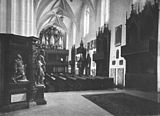
|
II / P | 30th | 1747 extended by one register; In 1813, 1836, 1875, 1910 and 1936 further changes were made; Destroyed in 1945 |
| 1720 | 15th | Dresden | Court chapel of the Dresden Residenzschloss (former opera house on Taschenberg ) | I. | ? | 1751 moved to the imperial chapel in Dresden Neustadt; Robbed by Russian troops in 1813 during the Wars of Liberation and has been missing since then | |
| 1718-1721 | 16 | Rötha | City Church of St. George |

|
II / P | 23 | 1935 renovations, especially the worm-eaten wooden pipes; receive; 1979–1980 restored by Eule → organ |
| 1721-1722 | 17th | Rötha | Marienkirche |

|
I / P | 11 | Preserved largely unchanged; Restored in 2008 by Ekkehart Groß → organ |
| 1721-1722 | 18th | Chemnitz | St. Johannis | I / P | 14th | 1792 extended by Johann Gottlob Trampeli by a superstructure; Sold to Auligk in 1879 , exchange of two registers; since 1958 in St. Kilian's Church , Bad Lausick (photo), expansion of the pedals; received changed; 1988 restored by owl → organ | |
| 1724 | 19th | Hilbersdorf | Evangelical village church |

|
I. | 5 | Since 1926 in the Leipzig Musical Instrument Museum ; Badly damaged in 1943; from 1964 attribution to Hildebrandt , from the 2010s securing the authorship of Silbermann; Restored in 2005 by Wieland Rühle |
| 1723-1725 | 20th | Reichenbach in Vogtland | City Church of St. Petri and Pauli | II / P | 29 | 1906 and 1927 greatly changed by Jehmlich ; Prospectus and wooden pipes received in the pedal; 1972 New building by Jehmlich including the preserved parts of the prospectus and four pedal registers → organ | |
| 1725 (?) | 21st | Ringethal | Castle chapel | I. | 6th | Originally in the castle chapel, converted into the village church in 1762 ; preserved largely unchanged; Restored in 1995 by Eule → organ | |
| 1726 | 22nd | Forchheim | Protestant church |

|
II / P | 20th | 1910 added an Aeoline 8 ′; 1917 confiscation of the prospectus pipes; largely preserved; Restored in 2001 by Wieland Rühle → organ |
| 1726 | 23 | Dittersbach near Stolpen | Village church |

|
I / P | 14th | The only unpainted Silbermann organ, painted in 1893 (paint removed in 1980); 1926 one register replaced; largely preserved; 1980 Restoration by Eule → Organ |
| 1724-1727 | 24 | Oederan | City Church | II / P | 24 | Neo-Gothic case from 1892, at the same time two registers replaced, which were removed and reinstalled in 1937; 1917 confiscation of the prospectus pipes; preserved modified (photo before 1890); 1992/1993 restored by Eule ; 1997 added a Vox humana 8 ′ on an additional loop → organ | |
| 1727 | 25th | Rochlitz | St. Petri | II / P | 20th | 1836 rebuilt and expanded by Carl Gottlob Gottleuber; Discontinued in 1894 and construction of Paul Schmeisser replaced | |
| 1727 (?) | 26th | Lebusa | Ev. Village church | I / P | 14th | 1953 worm-eaten wooden pipes replaced; largely preserved (94 percent of the pipe inventory); 1994–1997 restored by Jehmlich → organ | |
| 1728 (?) | 27 | Tiefenau | Castle chapel | I. | 9 | To the right of the altar empty case with blind pipes as a symmetrical counterpart; Organ badly damaged in 1945; Preserved remains; Reconstructed in 1997 by Wegscheider | |
| 1726-1728 | 28 | Helbigsdorf | Helbigsdorf Church |
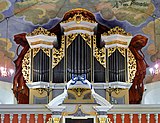
|
II / P | 17th | Silbermann's smallest two-manual organ; In 1935 and 1952 some wooden pipes replaced, in 1957 new pipe feet with four registers; largely preserved (96 percent of the metal pipes); Restored in 1994 by Jehmlich , the sound was revised by Wieland Rühle in 1998 → Organ |
| 1727-1729 | 29 | Püchau | Village church | II / P | 20th | Transferred to the new church in 1869; Demolished in 1922 and replaced by a new building by Jehmlich ; Manual keyboard partly preserved in the Silbermann Museum | |
| 1727-1730 | 30th | Glauchau | City church St. Georgen | II / P | 27 | 1836, 1853, 1891, 1936, 1949 repeatedly rescheduled; 1952–1953 Replacement of most of the metal pipes and installation of new cores in the remaining ones; 24 percent of the pipe inventory preserved, no unchanged metal pipe; 1997–1998 restoration by Eule , reconstruction of most of the stops → organ | |
| 1730 | 31 | Reichenbach in Vogtland | St. Trinity | I. | at 10 | Destroyed by fire in 1773 | |
| 1729-1731 | 32 | Reinhardtsgrimma | Village church |

|
II / P | 20th | Extensively revised in 1852, replacement of all wooden pipes, new pipe feet for all (half) closed metal pipes; receive; several pipes renewed or changed; 1997 restored by Wegscheider → organ |
| 1730-1731 | 33 | Mylau | City Church | II / P | 21st | Moved to the new church in 1890, fitted with a neo-Gothic case and partly replaced; One register each replaced in 1896 and 1911; two thirds of the registers preserved (photo before 1890); In 1997 Jehmlich restored the condition from 1896 → organ | |
| 1731-1732 | 34 | Crostau | Church of Crostau |

|
II / P | 20th | 1808 replacement of stolen tin pipes; Transferred to the new church in 1869; 1914 exchange of a register; receive; 2016 restoration by Eule → Organ |
| after 1731 | 35 | Freiberg | House organ for cathedral organist Johann Christoph Erselius | I. | 5 | Rented to Nikolaikirche from 1753; 1772 owned by the cathedral organist Johann Paul Zimmermann; 1776 sold to Nikolaikirche; In 1840 owned by the organ builder Karl Traugott Stöckel and has been lost since then | |
| after 1732 | Wegefarth | Village church | I. | ? | Attribution to Silbermann refuted; not received; lost after 1840 | ||
| before 1734 | 36 | Schweikershain | Village church | I / P | 6th | 1923 replaced one register; Moved to the west gallery in 1955; largely preserved → organ | |
| 1734 at the latest | 37 | Etzdorf | Village church | I. | 8th | Transferred to Wallroda in 1838 ; Moved to Bischofswerda in 1902 ; 1919 privately owned; from 1939 in the Bremen Cathedral ; 75 percent of the pipe inventory preserved; 1994 original disposition reconstructed and positively restored by Wegscheider ; served as a template for a replica in the Silbermann Museum; → organ | |
| 1734-1735 | 38 | Freiberg | City Church of St. Petri |

|
II / P | 32 | First large organ in a new design based on the Principals 16 ′ in the prospectus with elevated central tower; 1893–1895 action renewed, installation of a third manual with five stops and an additional pedal stop; 1959 echo mechanism removed and cores replaced in eight metal registers; largely preserved; 2006/2007 restored and reconstructed by Wegscheider and Jehmlich → organ |
| 1732-1736 | 39 | Dresden | woman Church | III / P | 43 | Prospectus draft after George Bähr and Johann Christian Feige ; Repaired in 1745 and 1818/1819, replacement of a register in 1874/1875; In 1903 Jehmlich added a few registers; 1911/1912 expanded and rebuilt by Johannes Jahn to IV / P / 65, 1939–1942 creation of an organ system with 85 registers and three console tables by Jehmlich by connecting the Jehmlich choir organ built in 1937 and the redesigned, now independent swell from 1912; up to the destruction in 1945, 42 of the 43 Silbermann registers were preserved; In 2005 no consistent reconstruction, but a new building with neoclassical French influences and expanded planning by Daniel Kern → Organ | |
| 1734-1737 | 40 | Ponitz | Friedenskirche (village church) |

|
II / P | 27 | 1782 installation of a carillon; 1936 Replacement of worm-eaten wooden pipes; largely completely preserved; Restored by Eule in 1984 → organ |
| 1734-1738 | 41 | Frauenstein | City Church | II / P | 20th | Destroyed by city fire in 1869; like the previous instrument from 1711 in 1728 | |
| 1735-1739 | 42 | Greiz | St. Mary | II / P | 31 | Destroyed by city fire in 1802 | |
| 1738-1741 | 43 | Zittau | St. Johannis | III / P | 44 | Destroyed in 1757 during the siege of Zittau in the Seven Years' War | |
| ? -1741 | 44 | Großhartmannsdorf | Großhartmannsdorf village church |

|
II / P | 21st | Preserved largely unchanged; Restored by Owl in 1967 ; further work in 1972 and 1990 → organ |
| 1736-1742 | 45 | Zöblitz | City Church |

|
II / P | 20th | 1903 one register removed and two added; largely preserved; 1996/1997 restored by Wieland Rühle → organ |
| 1739-1742 | 46 | Fraureuth | Village church | II / P | 20th | Maintenance work, in some cases with changes, in 1928 retuning to the current concert pitch by changing the tone action; 2018/2019 extensive restoration and restoration of the original pitch by Christoph Rühle ; preserved largely unchanged → organ | |
| ? -1743 | 47 | Burgk Castle | Castle chapel |
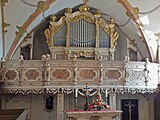
|
I / P | 12 | Preserved largely unchanged; Restored by Eule in 1982 → organ |
| 1748 | 48 | Nassau | Village church | II / P | 19th | Preserved largely unchanged; 1998 restored by Jehmlich → organ | |
| 1749 (?) - 1752 (?) | 49 | Frankenstein | Frankenstein village church | I / P | 13 | Completed by Johann Daniel Silbermann; Repaired in 1883 after fire damage; receive; 1997–1998 restored by Wieland Rühle including the prospect pipes from 1883 → organ | |
| 1750-1755 | 50 | Dresden | Catholic court church |

|
III / P | 47 | Mainly built by employees and completed after Silbermann's death; except housing and bellows outsourced in World War II; 1963–1971 rebuilt and the housing reconstructed using a photogrammetric method; 2001/2002 further reconstructed by Jehmlich and Wegscheider (restoration of the original concert pitch, replica of the bellows); Pipework preserved except for Unda maris; Changes largely eliminated → organ |
literature
- Christian Ahrens, Felix Friedrich (ed.): Gottfried Silbermann as an instrument maker (= Freiberg studies for the organ. No. 9). Kamprad, Altenburg 2006, ISBN 3-930550-41-5 .
- Badisches Landesmuseum Karlsruhe (ed.): Silbermann. History and legend of an organ building family. Exhibition catalog. Badisches Landesmuseum, Karlsruhe 2006, ISBN 3-7995-0218-1 .
- Ulrich Dähnert: Gottfried Silbermann's organs in Central Germany. Koehler and Amelang, Leipzig 1953.
- Ernst Flade: Gottfried Silbermann. A contribution to the history of German organ and piano construction in the age of Bach. 2nd Edition. Breitkopf & Härtel, Leipzig 1953.
- Klaus Gernhardt: The "instrument maker" Gottfried Silbermann. Special features and importance for piano construction in the 18th century. In: Felix Friedrich, Frank-Harald Greß u. a. (Ed.): Freiberg studies on the organ. Volume 6. Kamprad, Altenburg 1999, ISBN 3-930550-06-7 , pp. 29-36.
- Frank-Harald Greß : The sound of Gottfried Silbermann's organs. Breitkopf, Leipzig / Wiesbaden 1989, ISBN 3-923639-78-3 .
- Frank-Harald Greß, Michael Lange: The organs of Gottfried Silbermann (= publications of the Society of Organ Friends. No. 177). 3. Edition. Sandstein, Dresden 2007, ISBN 978-3-930382-50-7 .
- Werner Müller: In the footsteps of Gottfried Silbermann: a portrait of the famous organ builder; drawn from documented sources. 8th edition. Evangelische Verlags-Anstalt, Leipzig 1993, ISBN 3-374-01467-4 .
- Werner Müller: Gottfried Silbermann 1683–1753, Königl. Pohln. and Chur-Fürstl. Saxon. Well-appointed court and country organ builder in Freyberg. Contributions to the life and work of the Saxon organ builder. H-und-F-Verlag, Scheibenberg 1999, ISBN 3-933625-00-9 .
- Werner Müller: Gottfried Silbermann - Personality and Work. A documentation. German publishing house for music, Leipzig 1982, ISBN 3-920112-92-X .
- Conny Restle : Gottfried Silbermann and the fortepiano for the Prussian court in Potsdam. In: Yearbook of the State Institute for Music Research, Prussian Cultural Heritage. Merseburger, Berlin 2001, ISSN 0572-6239 , pp. 189-203 ( PDF; 3.15 MB ).
- Marc Schaefer (Ed.): The Silbermann Archive. The handwritten estate of the organ maker Johann Andreas Silbermann (1712–1783) (= Prattica Musicale. Volume 4; publication by the Society of Organ Friends. No. 123). Amadeus, Winterthur 1994, ISBN 3-905049-39-2 .
- City of Herne, Christian Ahrens (ed.): "We praise your art, your price is highly appreciated ..." - the organ builder Gottfried Silbermann (1683–1753). Symposium as part of the 28th Days of Early Music in Herne 2003. Katzbichler, Munich / Salzburg 2007, ISBN 978-3-87397-584-2 .
- Hermann Wettstein, Werner Müller: The organ building family Silbermann. Bibliography on her life and work (= Bibliotheca organologica. Volume 81). 2nd Edition. Knuf, Buren 1989, ISBN 90-6027-550-0 .
- Christoph Wolff , Markus Zepf: The organs of J. S. Bach. A manual . Evangelische Verlagsanstalt, Leipzig 2006, ISBN 3-374-02407-6 .
- Markus Zimmermann: Silbermann, Gottfried. In: New German Biography (NDB). Volume 24, Duncker & Humblot, Berlin 2010, ISBN 978-3-428-11205-0 , p. 409 f. ( Digitized version ).
Movie
- Silbermann - Two brothers conquer the world of organs ( Memento from February 5, 2016 in the Internet Archive ). In: mdr.de. November 26, 2015 (documentary by Steffen Jindra. MDR, 2014, 29:45 min.)
Web links
- Literature by and about Gottfried Silbermann in the Saxon Bibliography
- Gottfried Silbermann Society V.
- Silbermann Museum
- Silbermann's biography ( memento of March 10, 2013 in the Internet Archive ) on the Frauenstein website
- Biography and list of works on BaroqueMusic
- Short biography in New Attempts at Useful Collections… 1754 (more signs of contemporary appreciation than a quotable source)
- Numerous sound examples for Silbermann organs on YouTube
Individual evidence
- ↑ See the collection of contemporary hymns of praise at Müller: In the footsteps of Gottfried Silbermann. 1993, pp. 242-246.
- ↑ a b c Gernhardt: The "instrument maker" Gottfried Silbermann. 1999, p. 29, and see the overview at baroquemusic.org: Die Orgeln Gottfried Silbermanns. In: baroquemusic.org, accessed February 26, 2013.
- ↑ a b c Markus Zimmermann: Silbermann, Gottfried. In: New German Biography (NDB). Volume 24, Duncker & Humblot, Berlin 2010, ISBN 978-3-428-11205-0 , p. 409 f. ( Digitized version ).
- ↑ Müller: In the footsteps of Gottfried Silbermann. 1993, p. 7.
- ↑ Müller: In the footsteps of Gottfried Silbermann. 1993, p. 13.
- ↑ The alleged apprenticeship as a toy turner belongs to the realm of legend and was mainly due to Mooser: The brothers, the master organ builders Andreas and Gottfried Silbermann. Popularized in 1861, pp. 19-21 ( digitized version ).
- ↑ freiepresse.de from January 20, 2016: Kai Kollenberg: New find: Silbermann was a trained bookbinder , accessed on January 21, 2016.
- ↑ Hans Martin Balz : Bookbinder Silbermann? In: Ars Organi . Vol. 64, Issue 4, 2016, p. 257, suspects a namesake; the name Silbermann was quite common in the Freiburg area.
- ↑ Silbermann's submission to Elector Friedrich August II. Dated June 9, 1753, quoted from Müller: In the footsteps of Gottfried Silbermann. 1993, p. 56 f.
- ↑ Müller: In the footsteps of Gottfried Silbermann. 1993, p. 61.
- ↑ Müller: Gottfried Silbermann - Personality and Work. 1982, p. 115; on-line. In: Deutschlandradio Kultur , accessed on December 2, 2015.
- ↑ Greß: Gottfried Silbermann's organs. 2007, p. 26.
- ↑ Quoted from Schaefer (Ed.): Das Silbermann-Archiv. 1994, p. 460 f.
- ↑ Müller: In the footsteps of Gottfried Silbermann. 1993, p. 224.
- ↑ Müller: In the footsteps of Gottfried Silbermann. 1993, p. 230.
- ^ Frank-Harald Greß: The organ temperatures Gottfried Silbermanns. (= Freiberg studies on the organ 12 ). Kamprad, Altenburg 2010, ISBN 978-3-930550-66-1 , p. 18.
- ↑ Wolff, Zepf: The organs of JS Bach. 2006, p. 151.
- ↑ a b c Greß: The organs of Gottfried Silbermann. 2007, p. 30.
- ↑ Ernst Flade: The organ builder Gottfried Silbermann . 1926, p. 101 ( archive.org [accessed February 26, 2020]).
- ↑ Müller: In the footsteps of Gottfried Silbermann . 1993, p. 272.
- ↑ Obviously the grave remained without a monument. According to Ernst Heinrich Pfeilschmidt: The Johanneskirche and Johannesgemeinde in Dresden until the end of the second year since the election of their church council on May 30, 1877; a contribution to the history of the Dresden church, town and building . Pierson, Dresden 1879, p. 6, Silbermann's grave was moved to another cemetery in 1854; In 1858 the Johanniskirchhof was secularized and sold.
- ↑ Müller: In the footsteps of Gottfried Silbermann . 1993, p. 264 f.
- ↑ Müller: Gottfried Silbermann - Personality and Work. A documentation . 1982, p. 17.
- ↑ Breastwork, mainwork and upperwork are arranged one above the other, flanked on the sides by the two pedal towers.
- ↑ Wolff, Zepf: The organs of JS Bach. 2006, p. 161.
- ↑ Greß: Gottfried Silbermann's organs. 2007, p. 23.
- ↑ Greß: The sound of Gottfried Silbermann's organs. 1989, p. 39.
- ↑ Greß: The sound of Gottfried Silbermann's organs. 1989, pp. 35-39. The assignment to a category in opus 4 is unclear. Schweikersheim (opus 36) is with pedal.
- ^ Badisches Landesmuseum Karlsruhe (ed.): Silbermann. History and legend of an organ building family . 2006, p. 46.
- ↑ Greß: Gottfried Silbermann's organs. 2007, p. 22.
- ↑ Greß: The sound of Gottfried Silbermann's organs. 1989, p. 114.
- ^ Herbert Kelletat: On the musical temperature. I. Johann Sebastian Bach and his time. Merseburger, Berlin 1981, ISBN 3-87537-156-9 , p. 22 f.
- ^ Frank-Harald Greß: The organ temperatures Gottfried Silbermanns. (= Freiberg studies on the organ 12 ). Kamprad, Altenburg 2010, ISBN 978-3-930550-66-1 , pp. 28-30.
- ^ Bernhard Billeter: The Silbermann moods. In: Music Theory and Musical Practice. Collected Essays. (= Zurich Music Studies 4 ). Peter Lang, Bern 2004, ISBN 3-03910-375-X , pp. 107-120 ( limited preview in Google book search).
- ↑ Ernst Flade: The organ builder Gottfried Silbermann . 1926, p. 105 ( archive.org [accessed February 26, 2020]).
- ↑ Markus Zepf: “Yes, this lovely polyphonic Werck”. Construction and technology of the Silbermann organ. In: Badisches Landesmuseum Karlsruhe (ed.): Silbermann. History and legend of an organ building family . 2006, pp. 183, 187 (178-187).
- ↑ Greß: Gottfried Silbermann's organs. 2007, p. 25.
- ^ Ulrich Dähnert: Historical organs in Saxony. An organ inventory . VEB Deutscher Verlag für Musik, Frankfurt 1980, ISBN 3-920112-76-8 , p. 13 .
- ↑ Hans Martin Balz : Divine Music. Organs in Germany (= 230th publication by the Society of Organ Friends ). Konrad Theiss, Stuttgart 2008, ISBN 978-3-8062-2062-9 , pp. 90 .
- ↑ Greß: Gottfried Silbermann's organs. 2007, p. 124.
- ↑ Greß: Gottfried Silbermann's organs. 2007, p. 83 (Glauchau), 102 (Petrikirche Freiberg), 113 (Fraureuth), 114 (Greiz), 117 (Nassau).
- ↑ https://www.orgelbau-ruehle.de/silbermann-orgel-pfaffroda/
- ^ Jakob Adlung : Musica mechanica organoedi. Volume 1. Friedrich Wilhelm Birnstiel, Berlin 1768, p. 212 ( limited preview in the Google book search).
- ^ Ferdinand Klinda: Organ registration. Sound design of organ music. Wiesbaden, Breitkopf & Härtel 1987, ISBN 3-7651-0212-1 , p. 148.
- ^ Ferdinand Klinda: Organ registration. Sound design of organ music. Breitkopf & Härtel, Wiesbaden 1987, ISBN 3-7651-0212-1 , p. 149.
- ^ Müller: Gottfried Silbermann (1683-1753) . 1999, p. 36.
- ↑ Kenneth Sparr: The art of Silvius Leopold White in the mirror of contemporary literature. In: Guitar & Laute 9, 1987, No. 6, pp. 15-17; here: p. 16 f.
- ↑ Gernhardt: The "instrument maker" Gottfried Silbermann . 1999, pp. 30, 32.
- ^ Frank-Harald Greß: Gottfried Silbermann as an "instrument maker". In: Deutsche Clavichord Societät: Rundbrief. No. 59, December 2009, p. 12 (9-15).
- ↑ Ernst Flade: The organ builder Gottfried Silbermann. A contribution to the history of German organ building in the age of Bach. 2nd Edition. F. Kistner & CFW Siegel, Leipzig 1952, p. 242.
- ^ Robert Palmieri (Ed.): Encyclopaedia of the Piano. 2nd Edition. Routledge, New York 2003, ISBN 0-415-93796-5 , p. 345 ( limited preview in Google book search).
- ↑ Restle: Gottfried Silbermann and the fortepiano. 2001, p. 201 ( PDF; 3.3 MB ), accessed on February 9, 2014.
- ↑ According to Johann Nikolaus Forkel , the king bought 15 of these instruments: Johann Nikolaus Forkel : About Johann Sebastian Bach's life, art and works of art . Hoffmeister & Kühnel, Leipzig 1802, p. 10 ( online , accessed February 9, 2014). Restle contradicted this high number: Gottfried Silbermann and the fortepiano . 2001, pp. 190–192 ( PDF; 3.3 MB ), accessed on February 9, 2014.
- ↑ Hans-Joachim Schulze (Ed.): Documents on the aftermath of Johann Sebastian Bach 1750-1800 . (= Bach documents ; 3). Bärenreiter, Kassel 1984, p. 194.
- ↑ a b Gernhardt: The "instrument maker" Gottfried Silbermann. 1999, p. 30.
- ↑ Greß: Gottfried Silbermann's organs. 2007, pp. 165-171.
- ↑ Restle: Gottfried Silbermann and the fortepiano . 2001, p. 196 ( PDF; 3.3 MB ), accessed on February 9, 2014.
- ↑ Helmut Scheunchen: Grotthuss, Dietrich Ewald from the Kulturportal West-Ost , accessed on November 5, 2013.
- ↑ C. Ph. E. Bach : Farewell to the Silbermann piano in a rondeaux. Wq 66. / DE von Grotthuss: Joy at the reception of the Silbermann piano, in a rondeaux.
- ↑ "Gottfried Silbermann: Students & Journeyman". (No longer available online.) In: Frauenstein-erzgebirge.de. Archived from the original on March 10, 2013 ; accessed on December 28, 2017 . Info: The archive link was inserted automatically and has not yet been checked. Please check the original and archive link according to the instructions and then remove this notice. (The main page memento leads to a dead link on the subpage.)
- ↑ Wolfgang Hanke: The "Märkische Silbermann" Joachim Wagner - creator of the Prussian organ baroque. In: The Democrat. 37, No. 138 of June 15, 1982, p. 4.
- ^ Frank-Harald Greß: The organ landscape of Saxony. In: Badisches Landesmuseum Karlsruhe (ed.): Silbermann. History and legend of an organ building family. 2006, p. 81 (81 f.).
- ^ David Crombie: Piano. Evolution, design and performance. Balafon, London 1995, ISBN 1-871547-99-7 , p. 39.
- ↑ Conny Restle (Ed.): Fascination Piano. 300 years of piano production in Germany. Prestel, Munich / London / New York 2000, ISBN 3-7913-2308-3 , p. 84.
- ↑ a b Berit Drechsel: The Gottfried Silbermann organ of the Petrikirche in Freiberg. Origin - change - reconstruction. Sandstein, Dresden 2007, ISBN 978-3-940319-02-9 .
- ↑ a b Wolff, Zepf: The organs of JS Bach. 2006, p. 37 f.
- ↑ So in the acceptance report for the organ of the Dresden Frauenkirche, quoted by Müller: Gottfried Silbermann - Personality and Work. 1982, p. 490.
- ↑ Quoted from Greß: The sound shape of Gottfried Silbermann's organs. 1989, p. 96.
- ↑ Müller: Gottfried Silbermann - Personality and Work. 1982, p. 18; online at: Matthias Baxmann: "Go, posterity, there, admire his gifts". Gottfried Silbermann's organs in the Ore Mountains. In: Deutschlandradio. Retrieved March 25, 2014 .
- ↑ Greß: Gottfried Silbermann's organs. 2007, p. 167.
- ↑ According to the suggestion of Frank-Harald Greß: Silbermann oder Hildebrandt? The Hilbersdorfer parapet positive in the context of Silbermann's work. In: Ars Organi . 62, 2014.
- ↑ The heart of the Silbermann chest organ. About this instrument and its replica for the International Bach Academy Stuttgart by the organ workshop Wegscheider, on the website of the Bach Academy Stuttgart, accessed on August 27, 2019. Deviations from the original are the added fourth register (not in the sense of the Silbermann school), the extended Pitch range down by a whole tone, the sliding keyboard to change the tune from the chorus to the baroque Saxon concert pitch, the electric fan and the very powerful intonation.
- ↑ Greß: Gottfried Silbermann's organs. 2007, p. 137 f.
- ^ Wieland Josch: Experts inspect Oberbobritzsch organ. In: Freie Presse , May 22, 2017.
- ↑ Greß: Gottfried Silbermann's organs. 2007, p. 42.
- ↑ Organ of the Month December 2015. Opus 10 by the famous Baroque organ builder Silbermann in Niederschöna is being restored , accessed on March 26, 2018.
- ↑ Klaus Zimmermann: The organ of the Sankt-Annen-Kirche in Niederschöna - the restoration. On orgel-information.de accessed 3 August 2016th
- ↑ Klaus Zimmermann: Niederschöna Silbermann organ sounds again. In: Communications from the Gottfried Silbermann Society e. V., 19th edition, July 2016, p. 3.
- ↑ Wolfram Hackel, Cristine Zimmermann, Peter Härtel: Silbermann - Hildebrandt - Silbermann (PDF file; 356 kB), accessed on February 28, 2014.
- ↑ Greß: Gottfried Silbermann's organs. 2007, pp. 145, 147.
- ↑ Greß: Gottfried Silbermann's organs. 2007, p. 70.
- ↑ Greß: Gottfried Silbermann's organs. 2007, p. 72.
- ↑ Greß: Gottfried Silbermann's organs. 2007, p. 79 f.
- ↑ Greß: Gottfried Silbermann's organs. 2007, p. 83 f.
- ↑ Greß: Gottfried Silbermann's organs. 2007, p. 151.
- ↑ Greß: Gottfried Silbermann's organs. 2007, p. 95 f.
- ↑ Hans Martin Balz: Divine Music. Organs in Germany (= 230th publication by the Society of Organ Friends ). Konrad Theiss, Stuttgart 2008, ISBN 978-3-8062-2062-9 , pp. 100 .
| personal data | |
|---|---|
| SURNAME | Silbermann, Gottfried |
| ALTERNATIVE NAMES | Silbermann, Johann Gottfried (full name) |
| BRIEF DESCRIPTION | German organ builder |
| DATE OF BIRTH | January 14, 1683 |
| PLACE OF BIRTH | Kleinbobritzsch |
| DATE OF DEATH | 4th August 1753 |
| Place of death | Dresden |



